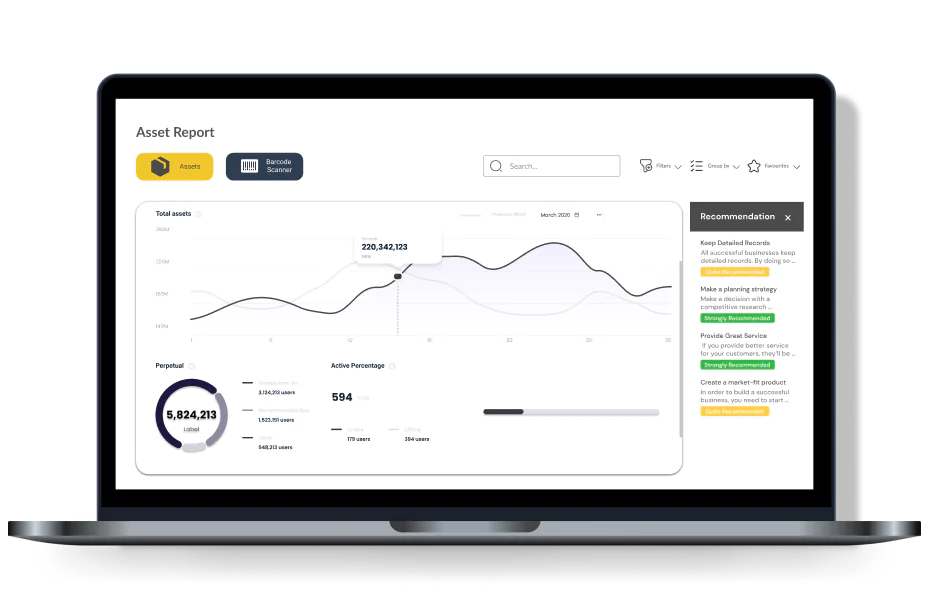Struggling with financial management in your negosyo? An effective asset management system powers the smooth operation you have always wanted! Utilizing a robust accounting program isn’t just beneficial—it’s crucial for managing your company’s financial operations.
Assets and liabilities, from cash flow and accounts receivable to physical assets like your office building, are the pillars that support your business. To ensure everything runs seamlessly and efficiently, implementing an Asset Management System is essential.
These systems automate asset calculations, becoming indispensable as today’s business climate demands cutting-edge technology solutions. Keep reading to discover how you can transform your asset management and drive business success!
Key Takeaways
|
Table of Contents

What are Assets?

Assets encompass all of a company’s properties that can be quantified in monetary terms. These include tangible items such as cash, inventory, and real estate and intangible assets like patents and trademarks.
Originating from past transactions, the value of these assets can fluctuate due to market conditions and economic factors. At the inception of a business, assets typically serve as the initial capital.
While assets are often thought of as cash, they actually include all the financial and physical items a company owns, gained through various transactions. This broad view shows how important assets are to a company’s financial health.
What is a Current Asset?
A current asset is any asset that a company expects to convert into cash or consume within one year or a normal operating cycle, whichever is longer. These assets are crucial for managing day-to-day operations and funding ongoing business activities. Here are three common examples:
- Cash and Cash Equivalents: This category includes cash on hand, petty cash, and liquid securities that can be quickly converted into a set cash amount, such as money in checking or savings accounts.
- Accounts Receivable: This represents money owed by customers for goods or services already delivered but not yet paid for. For example, a manufacturer might have invoices outstanding that clients will pay within 30 days.
- Inventory: These are goods and materials that a business holds for the purpose of resale, ranging from raw materials to finished goods awaiting sale.
Understanding these current assets helps businesses effectively manage their liquidity and secure the funding needed for their operational requirements.
Discover how Enterprise Asset Management Software can streamline your operations—click the banner below to explore pricing options tailored to your needs!
What is a Non-Current Asset?
A non-current asset is a long-term asset that a company does not expect to convert into cash within one year of the balance sheet date such as managing a facility that your business own. These assets are critical for a business’s long-term financial strategy and operational infrastructure.
Here are three common examples:
- Property, Plant, and Equipment (PP&E): These are tangible assets a company uses in its production or supply process and expects to use for more than one year. Examples include land, buildings, machinery, and vehicles.
- Intangible Assets: These assets do not have physical substance but offer long-term value to the company. Common intangible assets include patents, copyrights, trademarks, and goodwill.
- Long-term Investments: Investments that a company holds for more than one year, such as bonds, stocks of other companies, or real estate held for investment purposes.
Understanding the types and roles of non-current assets can help businesses plan for the future and allocate resources for sustainable growth.
Current vs. Non-Current Assets
Assets are typically divided into two categories based on their liquidity:
| Asset | Difference |
|---|---|
| Current Assets | These assets can be quickly converted into cash within a year. High liquidity is a key feature, allowing these assets to be used to cover operational expenses. Examples include cash, marketable securities, accounts receivable, and inventory. |
| Non-Current Assets | These assets are less liquid and generally take over a year to convert into cash. They include fixed assets like land and buildings, intangible assets such as patents, and long-term investments like stocks held beyond a year. |
The Benefits of Asset Management Systems in Monitoring Current Assets
Implementing an Asset Management System can significantly enhance how you manage and monitor your company’s assets, bringing numerous operational advantages.
- Asset Tracking: Simplifies asset tracking through serial numbers and barcodes, enabling quick identification and verification.
- Value Evaluation: Automatically determines the return on investment (ROI) and calculates associated costs, facilitating informed strategic financial decisions.
- Operational Efficiency: Improves productivity by providing detailed asset information, including valuations and comprehensive documentation.
- Risk Management: Helps identify and manage risks associated with asset depreciation and obsolescence, ensuring the assets maintain their value and utility.
- Regulatory Compliance: Ensures compliance with financial regulations by maintaining accurate and timely records of all asset transactions and histories.
These benefits clearly underscore the importance of an asset management system in maintaining a business’s financial agility and operational integrity. Consequently, by integrating such a system, companies can more effectively track their assets, leading to sustained business growth and success.
Manage Current Assets with HashMicro’s Asset Management System

HashMicro’s Asset Management System provides an effective way to manage and optimize your current assets. This system is designed to enhance the accuracy and efficiency of asset management through several key features:
- Asset Stock Take with Barcode: Streamline inventory checks and reduce errors with barcode scanning, making asset tracking fast and reliable.
- Asset GPS Tracking: Monitor the real-time location of your assets, improving security and operational efficiency.
- QR Code Scanning for Facilities Request: Simplify the management of facilities requests using QR codes, enhancing response times and service quality.
- Fully Integrated with Accounting to Track Depreciation: Keep your financials in check with an asset management system that automatically calculates depreciation, integrating seamlessly with your accounting software.
Implementing HashMicro’s Asset Management System can significantly transform how you track, evaluate, and maintain your current assets. A dedicated asset management software enhances operational efficiency by automating asset tracking, maintenance, and timely data.
Conclusion
Effective asset management is not just an operational necessity but a strategic advantage. The distinction between current and non-current assets highlights the diverse nature of business resources, each serving unique financial roles. By leveraging HashMicro’s Asset Management System, businesses can optimize the management of these assets.
HashMicro’s comprehensive system enhances the efficiency and accuracy of managing current and non-current assets. From real-time GPS tracking to seamless integration with accounting systems. Try our free demo and see firsthand how HashMicro can transform your asset management strategy today!
Frequently Asked Questions
-
What are examples of current assets?
Current assets are assets that a company expects to convert into cash or consume within one year or within its operating cycle, whichever is longer. These assets are essential for funding day-to-day operations and include cash, inventory, and accounts receivable.
-
What are examples of current assets?
Current assets typically include cash and cash equivalents, accounts receivable, funds owed to the company, and inventory, encompassing products held for sale in the ordinary business.
-
What are examples of current liabilities?
Examples of current liabilities are financial obligations a company is expected to settle within a year or its operating cycle. This category includes accounts payable, wages payable, and accrued expenses such as taxes and utilities.





































